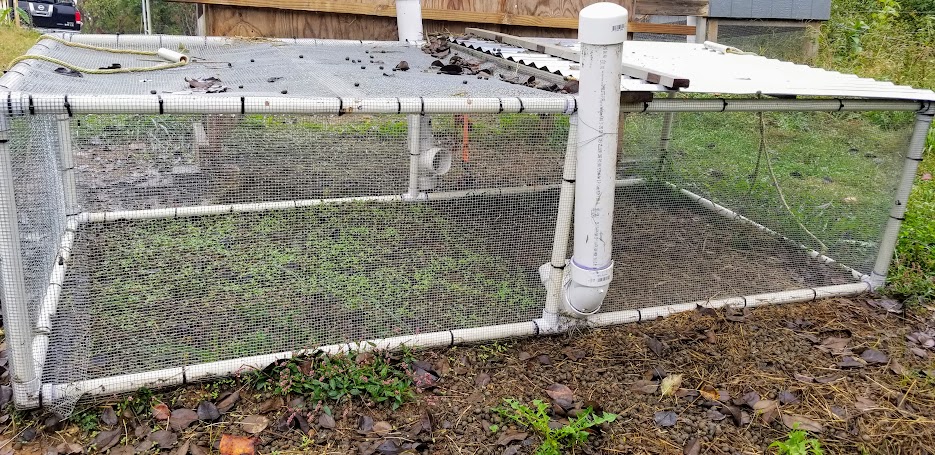Chicken Tractor: The Holmestead Version
Just as there are many designs for chicken coops, there are equally as many designs for chicken tractors. If you are unfamiliar with a chicken tractor, its premise is to be a moveable chicken coop. By moving it daily, the chickens have constant access to fresh grass and bugs. The idea is to get the benefits of free ranging without the negatives. Inside the chicken tractor is everything the chickens need (shelter, food, and water). If the chickens are egg-laying, then it would also have nest boxes. We used our chicken tractor as a grow-out space from the time our chicks were feathered out (8 weeks old) until our chicken coop was completed.

Exterior Construction:
We constructed the frame of our chicken tractor out of 1.5 inch PVC pipe because that’s what we had on hand. If we were to make it again, we would use larger diameter PVC. Using larger PVC would move the chickens along better as we dragged it. With the smaller diameter, we did have an issue with it catching their feet. It took awhile for the chicks and James to get accustomed to it. Unfortunately, one chick got its leg under it once and limped enough that the others started pecking it. The chick was in very bad condition when we noticed it. Fortunately, we were able to separate it, rehabilitate it, and reintroduce it to the flock.
The sides and top were covered with hardware cloth to make it predator proof. We would also lay down wire metal shelving on the outside anywhere there was unevenness on the ground. This is the same wire metal shelving we put around our chicken coop as a dig defense.
On either end of the chicken tractor, we installed rope handles. This allowed us to pull the chicken tractor across our lawn daily, thereby giving our chickens access to fresh greens and bugs.
Feeders and Waterers for Our Chicken Tractor
For feeders, we used 3 inch PVC. If you look closely in the above pictures, you can see two different styles. We prefer the feeder that is closer to us in a “J” shape made by connecting a 22.5 degrees with a 45 degree elbow to the upright piece. This is what we have installed in our permanent chicken coop. We have two of them, and they can hold days worth of food for our current flock of 6 chickens.

The metal roof is on a hinge and can be lifted for access to the inside, where we had our waterer. We used a 5 gallon waterer inside the chicken tractor, which had to be removed in order for the tractor to be moved. That waterer is now in our chicken coop. As you can see, James installed chicken watering cups on a 5 gallon bucket. This can hold at least a weeks worth of water. If we choose to use our chicken tractor again with a separate group of chickens, James will have to build a second waterer.
While our chicken tractor is currently not in use, it has been a valuable part of our growth. It was a much quicker and affordable shelter to build for our chickens than the permanent coop. We used it a second time when we purchased a second group of pullets. We housed them in the tractor, but kept them next to the coop so they could begin the introduction process with our current flock. If we were to do it all over again, we would have used larger PVC for the frame, but otherwise, it was a well-planned build.
